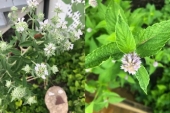Blake Lenoir wrote: How beneficial is dittny? And how can we tell if wild grapes are suitable as an edible?
Dittnay is similar to Oregano or Bees Balm as it contains the compound Thymol. Thymol is anti-inflammatory, anti-viral, anti-bacterial, antiseptic.
As far as wild grapes go, they grow all over the place on my property…. And I’ve never been able to harvest any grapes. My experience is that wild Grapes are very small and they only ripen on the vine and you have to compete with birds to get them. Cultivated varieties are much easier. And of course, in the wild they grow along side or mixed in with poisonous vines like moonseed, poison ivy, Virginia creeper. It’s just easier for me to know what and where I planted something in an easily cultivated spot. However, wild Grape Leaves are easy enough to forage and edible. And I did once come upon a bunch of wild grapes when visiting Michigan that were plentiful and easy to harvest, so, there might be environments or varieties that are more suitable. There are a lot of different kinds or wild grapes…. I haven’t spent much effort trying to learn about the different wild varieties or identify which ones naturally occur at my property.







